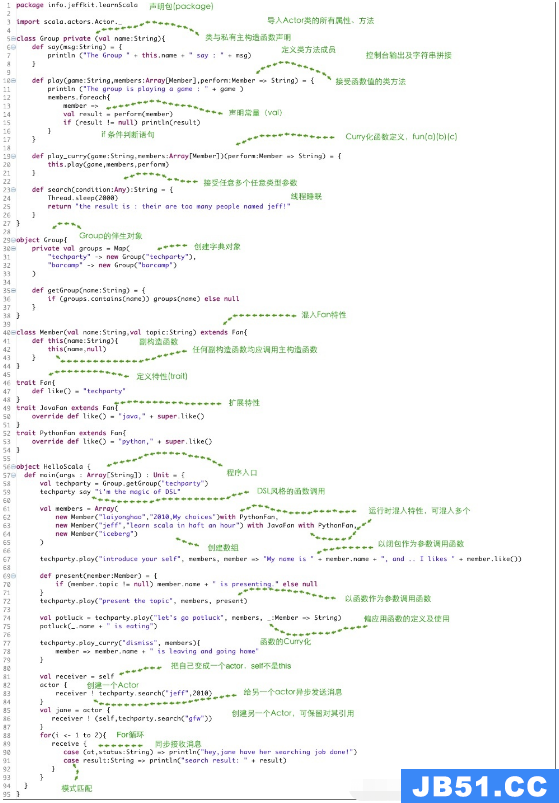Enumeration应该算是程序语言里面比较通用的一个类型,在scala中也存在这样的类型, 我们看下Enumeration的定义:
abstract class Enumeration (initial: Int) extends Serializable
Enumeration是一个抽象类,它定义四个value方法,来设置内部的值, 四个value方法如下定义:
/** Creates a fresh value,part of this enumeration. */
protected final def Value: Value = Value(nextId)
/** Creates a fresh value,part of this enumeration,identified by the
* integer `i`.
*
* @param i An integer that identifies this value at run-time. It must be
* unique amongst all values of the enumeration.
* @return Fresh value identified by `i`.
*/
protected final def Value(i: Int): Value = Value(i,nextNameOrNull)
/** Creates a fresh value,called `name`.
*
* @param name A human-readable name for that value.
* @return Fresh value called `name`.
*/
protected final def Value(name: String): Value = Value(nextId,name)
/** Creates a fresh value,called `name`
* and identified by the integer `i`.
*
* @param i An integer that identifies this value at run-time. It must be
* unique amongst all values of the enumeration.
* @param name A human-readable name for that value.
* @return Fresh value with the provided identifier `i` and name `name`.
*/
protected final def Value(i: Int,name: String): Value = new Val(i,name)
知道如何设置Enum的值后,我们就可以尝试创建一个Enum了。
println("Step 1: How to create an enumeration")
object Donut extends Enumeration {
type Donut = Value
val Glazed = Value("Glazed")
val Strawberry = Value("Strawberry")
val Plain = Value("Plain")
val Vanilla = Value("Vanilla")
}
上面的例子中,我们创建了一个Enum,并且设置了几个值。
下面我们看下怎么取到Enum的值:
println("\nStep 2: How to print the String value of the enumeration")
println(s"Vanilla Donut string value = ${Donut.Vanilla}")
你可以看到如下的输出:
Step 2: How to print the String value of the enumeration
Vanilla Donut string value = Vanilla
下面是怎么输出Enum的id:
println("\nStep 3: How to print the id of the enumeration")
println(s"Vanilla Donut's id = ${Donut.Vanilla.id}")
结果如下:
Step 3: How to print the id of the enumeration
Vanilla Donut's id = 3
怎么输出所有的Enum项呢?
println("\nStep 4: How to print all the values listed in Enumeration")
println(s"Donut types = ${Donut.values}")
输出结果如下:
Step 4: How to print all the values listed in Enumeration
Donut types = Donut.ValueSet(Glazed,Strawberry,Plain,Vanilla)
接下来,我们看下怎么打印出所有的Enum:
println("\nStep 5: How to pattern match on enumeration values")
Donut.values.foreach {
case d if (d == Donut.Strawberry || d == Donut.Glazed) => println(s"Found favourite donut = $d")
case _ => None
}
输出如下:
Step 5: How to pattern match on enumeration values
Found favourite donut = Glazed
Found favourite donut = Strawberry
最后,我们看下怎么改变Enum值的顺序:
println("\nStep 6: How to change the default ordering of enumeration values")
object DonutTaste extends Enumeration{
type DonutTaste = Value
val Tasty = Value(0,"Tasty")
val VeryTasty = Value(1,"Very Tasty")
val Ok = Value(-1,"Ok")
}
println(s"Donut taste values = ${DonutTaste.values}")
println(s"Donut taste of OK id = ${DonutTaste.Ok.id}")
输出结果如下:
Step 6: How to change the default ordering of enumeration values
Donut taste values = DonutTaste.ValueSet(Ok,Tasty,Very Tasty)
Donut taste of OK id = -1
更多教程请参考 flydean的博客

 共收录Twitter的14款开源软件,第1页Twitter的Emoji表情 Tw...
共收录Twitter的14款开源软件,第1页Twitter的Emoji表情 Tw... 本篇内容主要讲解“Scala怎么使用”,感兴趣的朋友不妨来看看...
本篇内容主要讲解“Scala怎么使用”,感兴趣的朋友不妨来看看...